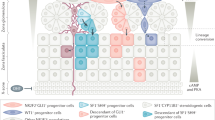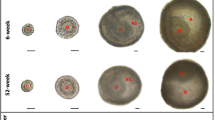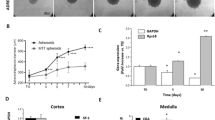Abstract
Estrogen deficiency mediates aging, but the underlying mechanism remains to be fully determined. We report here that estrogen deficiency caused by targeted disruption of aromatase in mice results in significant inhibition of telomerase activity in the adrenal gland in vivo. Gene expression analysis showed that, in the absence of estrogen, telomerase reverse transcriptase (TERT) gene expression is reduced in association with compromised cell proliferation in the adrenal gland cortex and adrenal atrophy. Stem cells positive in c-kit are identified to populate in the parenchyma of adrenal cortex. Analysis of telomeres revealed that estrogen deficiency results in significantly shorter telomeres in the adrenal cortex than that in wild-type (WT) control mice. To further establish the causal effects of estrogen, we conducted an estrogen replacement therapy in these estrogen-deficient animals. Administration of estrogen for 3 weeks restores TERT gene expression, telomerase activity and cell proliferation in estrogen-deficient mice. Thus, our data show for the first time that estrogen deficiency causes inhibitions of TERT gene expression, telomerase activity, telomere maintenance, and cell proliferation in the adrenal gland of mice in vivo, suggesting that telomerase inhibition and telomere shortening may mediate cell proliferation arrest in the adrenal gland, thus contributing to estrogen deficiency-induced aging under physiological conditions.
Similar content being viewed by others
Log in or create a free account to read this content
Gain free access to this article, as well as selected content from this journal and more on nature.com
or
References
Allain JE, Dagher I, Mahieu-Caputo D, et al. Immortalization of a primate bipotent epithelial liver stem cell. Proc Natl Acad Sci USA 2002; 99:3639–3644.
DeNardo DG, Kim H-T, Hilsenbeck S, et al. Global gene expression analysis of estrogen receptor transcription factor cross talk in breast cancer: identification of estrogen-induced/activator protein-1-dependent genes. Mol Endocrinol (Baltimore, MD) 2005; 19:362–378.
Cheng ASL, Jin VX, Fan M, et al. Combinatorial analysis of transcription factor partners reveals recruitment of c-MYC to estrogen receptor-[alpha] responsive promoters. Mol Cell 2006; 21:393–404.
Bayne S, Liu JP . Hormones and growth factors regulate telomerase activity in ageing and cancer. Mol Cell Endocrinol 2005; 240:11–22.
Bayne S, Jones ME, Li H, Liu JP . Potential roles for estrogen regulation of telomerase activity in aging. Ann N Y Acad Sci 2007; 1114:48–55.
Liu JP . Studies of the molecular mechanisms in the regulation of telomerase activity. FASEB J 1999; 13:2091–2104.
Liu JP, Deb S, Li H . Regulation of telomerase activity. In: Krupp G, Parwaresch R, eds. Telomeres and Telomerases: Cancer and Biology. New York: Landes Bioscience/Eurekah.com, 2002:134–159.
Liu JP, Cassar L, Pinto A, Li H . Mechanisms of cell immortalization mediated by EB viral activation of telomerase in nasopharyngeal carcinoma. Cell Res 2006; 16:809–817.
Blackburn EH . Telomeres and telomerase: their mechanisms of action and the effects of altering their functions. FEBS Lett 2005; 579:859–862.
Blasco MA . Telomeres and human disease: ageing, cancer and beyond. Nat Rev Genet 2005; 6:611–622.
Hahn WC . Telomere and telomerase dynamics in human cells. Curr Mol Med 2005; 5:227–231.
Dwyer J, Li H, Xu D, Liu JP . Transcriptional regulation of telomerase activity: roles of the ets transcription factor family. Ann N Y Acad Sci 2007; 1114:36–47.
Li H, Liu JP . Mechanisms of action of TGF-beta in cancer: evidence for Smad3 as a repressor of the hTERT gene. Ann N Y Acad Sci 2007; 1114:56–68.
Cong YS, Wen J, Bacchetti S . The human telomerase catalytic subunit hTERT: organization of the gene and characterization of the promoter. Hum Mol Genet 1999; 8:137–142.
Horikawa I, Cable PL, Mazur SJ, et al. Downstream E-box-mediated regulation of the human telomerase reverse transcriptase (hTERT) gene transcription: evidence for an endogenous mechanism of transcriptional repression. Mol Biol Cell 2002; 13:2585–2597.
Kyo S, Inoue M . Complex regulatory mechanisms of telomerase activity in normal and cancer cells: How can we apply them for cancer therapy? Oncogene 2002; 21:688–697.
Wu KJ, Grandori C, Amacker M, et al. Direct activation of TERT transcription by c-MYC. Nat Genet 1999; 21:220–224.
Xu D, Popov N, Hou M, et al. Switch from Myc/Max to Mad1/Max binding and decrease in histone acetylation at the telomerase reverse transcriptase promoter during differentiation of HL60 cells. Proc Natl Acad Sci USA 2001; 98:3826–3831.
Li H, Xu D, Li J, et al. Transforming growth factor beta suppresses human telomerase reverse transcriptase (hTERT) by Smad3 interactions with c-Myc and the hTERT gene. J Biol Chem 2006; 281:25588–25600.
Ling S, Zhou L, Li H, et al. Effects of 17beta-estradiol on growth and apoptosis in human vascular endothelial cells: iInfluence of mechanical strain and tumor necrosis factor-alpha. Steroids 2006; 71:799–808.
Misiti S, Nanni S, Fontemaggi G, et al. Induction of hTERT expression and telomerase activity by estrogens in human ovary epithelium cells. Mol Cell Biol 2000; 20:3764–3771.
Kyo S, Takakura M, Kanaya T, et al. Estrogen activates telomerase. Cancer Res 1999; 59:5917–5921.
Chadeneau C, Siegel P, Harley CB, et al. Telomerase activity in normal and malignant murine tissues. Oncogene 1995; 11:893–898.
Burger A, Double J . Telomerase activity in normal and malignant mammalian tissues: feasibility of telomerase as a target for chancer chemotherapy. Br J Cancer 1997; 75:516–522.
Prowse K, Greider C . Developmental and tissue-specific regulation of mouse telomerase and telomere length. Proc Natl Acad Sci USA 1995; 92:4818–4822.
Tischler AS, Powers JF, Shahsavari M, et al. Comparative studies of chromaffin cell proliferation in the adrenal medulla of rats and mice. Fundam Appl Toxicol 1997; 35:216–220.
Zajicek G, Ariel I, Arber N . The streaming adrenal cortex: direct evidence of centripetal migration of adrenocytes by estimation of cell turnover rate. J Endocrinol 1986; 111:477–482.
Verhofstad AA . Kinetics of adrenal medullary cells. J Anat 1993; 183:315–326.
Scholzen T, Gerdes J . The Ki-67 protein: from the known and the unknown. J Cell Physiol 2000; 182:311–322.
Kim AC, Hammer GD . Adrenocortical cells with stem/progenitor cell properties: recent advances. Mol Cell Endocrinol 2007; 265–266:10–16.
Barile L, Chimenti I, Gaetani R, et al. Cardiac stem cells: isolation, expansion and experimental use for myocardial regeneration. Nat Clin Pract Cardiovasc Med 2007; 4 Suppl 1:S9–S14.
Okada S, Nakauchi H, Nagayoshi K, et al. In vivo and in vitro stem cell function of c-kit- and Sca-1-positive murine hematopoietic cells. Blood 1992; 80:3044–3050.
Spangrude GJ, Heimfeld S, Weissman IL . Purification and characterization of mouse hematopoietic stem cells. Science 1988; 241:58–62.
Manova K, Huang EJ, Angeles M, et al. The expression pattern of the c-kit ligand in gonads of mice supports a role for the c-kit receptor in oocyte growth and in proliferation of spermatogonia. Dev Biol 1993; 157:85–99.
Blasco MA . Telomere length, stem cells and aging. Nat Chem Biol 2007; 3:640–649.
Huang Q, Chen M, Liang S, et al. Improving cell therapy – experiments using transplanted telomerase-immortalized cells in immunodeficient mice. Mech Ageing Dev 2007; 128:25–30.
Li H, Pinto AR, Duan W, et al. Telomerase down-regulation does not mediate PC12 pheochromocytoma cell differentiation induced by NGF, but requires MAP kinase signalling. J Neurochem 2005; 95:891–901.
Winter CA, Emery FE . Compensatory adrenal hypertrophy in the rat as influenced by sex, castration, time and thymectomy. Anat Rec 1936; 66:401–409.
Mitani F, Mukai K, Miyamoto H, et al. Development of functional zonation in the rat adrenal cortex. Endocrinology 1999; 140:3342–3353.
Flores I, Cayuela ML, Blasco MA . Effects of telomerase and telomere length on epidermal stem cell behaviour. Science 2005; 309:1253–1256.
Sarin KY, Cheung P, Gilison D, et al. Conditional telomerase induction causes proliferation of hair follicle stem cells. Nature 2005; 436:1048–1052.
Yamaguchi H, Calado RT, Ly H, et al. Mutations in TERT, the gene for telomerase reverse transcriptase, in aplastic anemia. N Engl J Med 2005; 352:1413–1424.
Toda K, Hayashi Y, Okada T, et al. Expression of the estrogen-inducible EGFP gene in aromatase-null mice reveals differential tissue responses to estrogenic compounds. Mol Cell Endocrinol 2005; 229:119–126.
Muller RE, Wotiz HH . Estrogen-binding protein in mouse and rat adrenal glands. J Biol Chem 1978; 253:740–745.
Greenberg RA, O'Hagan RC, Deng H, et al. Telomerase reverse transcriptase gene is a direct target of c-Myc but is not functionally equivalent in cellular transformation. Oncogene 1999; 18:1219–1226.
Santos GF, Scott GK, Lee WMF, et al. Estrogen-induced post-transcriptional modulation of c-myc proto-oncogene expression in human breast cancer cells. J Biol Chem 1988; 263:9565–9568.
Sarkar P, Shiizaki K, Yonemoto J, Sone H . Activation of telomerase in BeWo cells by estrogen and 2,3,7,8-tetrachlorodibenzo-p-dioxin in co-operation with c-Myc. Int J Oncol 2006; 28:43–51.
Revankar CM, Cimino DF, Sklar LA, et al. A transmembrane intracellular estrogen receptor mediates rapid cell signaling. Science 2005; 307:1625–1630.
Segars J, Driggers P . Estrogen action and cytoplasmic signaling cascades. Part I: Membrane-associated signaling complexes. Trends Endocrinol Metab 2002; 13:349–354.
Liu C, Fang X, Ge Z, et al. The telomerase reverse transcriptase (hTERT) gene is a direct target of the histone methyltransferase SMYD3. Cancer Res 2007; 67:2626–2631.
Zhang DH, Zhou B, Huang Y, et al. The human Pif1 helicase, a potential Escherichia coli RecD homologue, inhibits telomerase activity. Nucleic Acids Res 2006; 34:1393–1404.
Xin H, Liu D, Wan M, et al. TPP1 is a homologue of ciliate TEBP-beta and interacts with POT1 to recruit telomerase. Nature 2007; 445:559–562.
Fisher CR, Graves KH, Parlow AF, Simpson ER . Characterization of mice deficient in aromatase (ArKO) because of targeted disruption of the cyp19 gene. Proc Natl Acad Sci USA 1998; 95:6965–6970.
Jones M, Thorburn A, Britt K, et al. Aromatase-deficient (ArKO) mice have a phenotype of increased adiposity. Proc Natl Acad Sci USA 2000; 97:12735–12740.
Li H, Zhao LL, Funder JW, Liu JP . Protein phosphatase 2A inhibits nuclear telomerase activity in human breast cancer cells. J Biol Chem 1997; 272:16729–16732.
Rufer N, Dragowska W, Thornbury G, et al. Telomere length dynamics in human lymphocyte subpopulations measured by flow cytometry. Nat Biotechnol 1998; 16:743–747.
Acknowledgements
We thank Peter Lansdorp for the TFL-Telo 2.2 software program for telomere analysis. This work was supported by grants from the National Health and Medical Research Council of Australia, Australia Research Council, and Cancer Council of Victoria, Australia. MEJ was the recipient of an RD Wright Career Development Award and SB was the recipient of an Australian Postgraduate Award.
Author information
Authors and Affiliations
Corresponding authors
Rights and permissions
About this article
Cite this article
Bayne, S., Jones, M., Li, H. et al. Estrogen deficiency leads to telomerase inhibition, telomere shortening and reduced cell proliferation in the adrenal gland of mice. Cell Res 18, 1141–1150 (2008). https://doi.org/10.1038/cr.2008.291
Received:
Revised:
Accepted:
Published:
Issue date:
DOI: https://doi.org/10.1038/cr.2008.291
Keywords
This article is cited by
-
Idiopathic early ovarian aging: is there a relation with premenopausal accelerated biological aging in young women with diminished response to ART?
Journal of Assisted Reproduction and Genetics (2021)
-
BPA exposure is associated with non-monotonic alteration in ESR1 promoter methylation in peripheral blood of men and shorter relative telomere length in peripheral blood of women
Journal of Exposure Science & Environmental Epidemiology (2019)
-
Emerging therapies for idiopathic pulmonary fibrosis, a progressive age-related disease
Nature Reviews Drug Discovery (2017)
-
Age at maturation has sex- and temperature-specific effects on telomere length in a fish
Oecologia (2017)
-
Accelerated telomere shortening in peripheral blood lymphocytes after occupational polychlorinated biphenyls exposure
Archives of Toxicology (2017)



